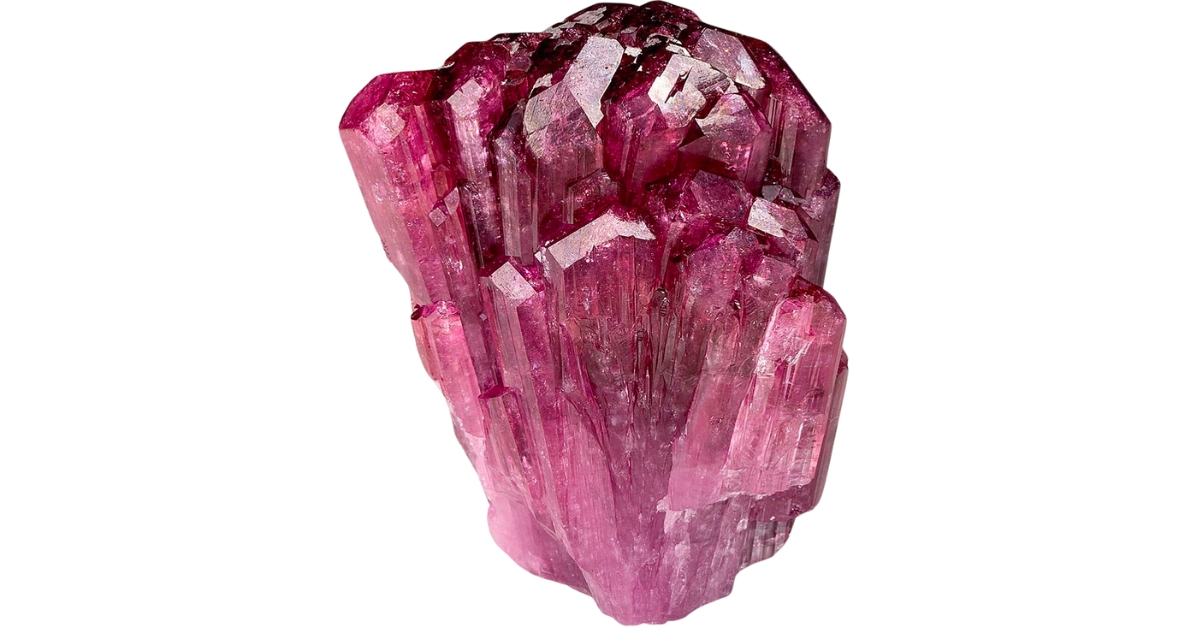Did you know that tourmaline isn’t just one single rock? It’s a group of minerals that come in an amazing variety of colors. If you want to get to know the different types of tourmaline, you’re in for a treat!
But first, what does tourmaline look like? It can be pink, green, blue, yellow, and even black. Some even show several colors in one crystal.
This gem is formed under high pressure and temperature conditions. It’s often found in places with volcanic rocks and granite. What makes it special is its ability to display electric charges when heated or put under pressure.
Ready to discover all the dazzling types of tourmaline? We are, too, so let’s begin!
The 15 Different Types Of Tourmaline And What They Look Like
As one of the most fascinating and diverse gemstones you’ll ever come across, the value of tourmaline comes from its stunning range of colors and its amazing properties.
This gemstone has something for everyone, whether you’re interested in its science, its history, or just its sheer beauty.
Elbaite
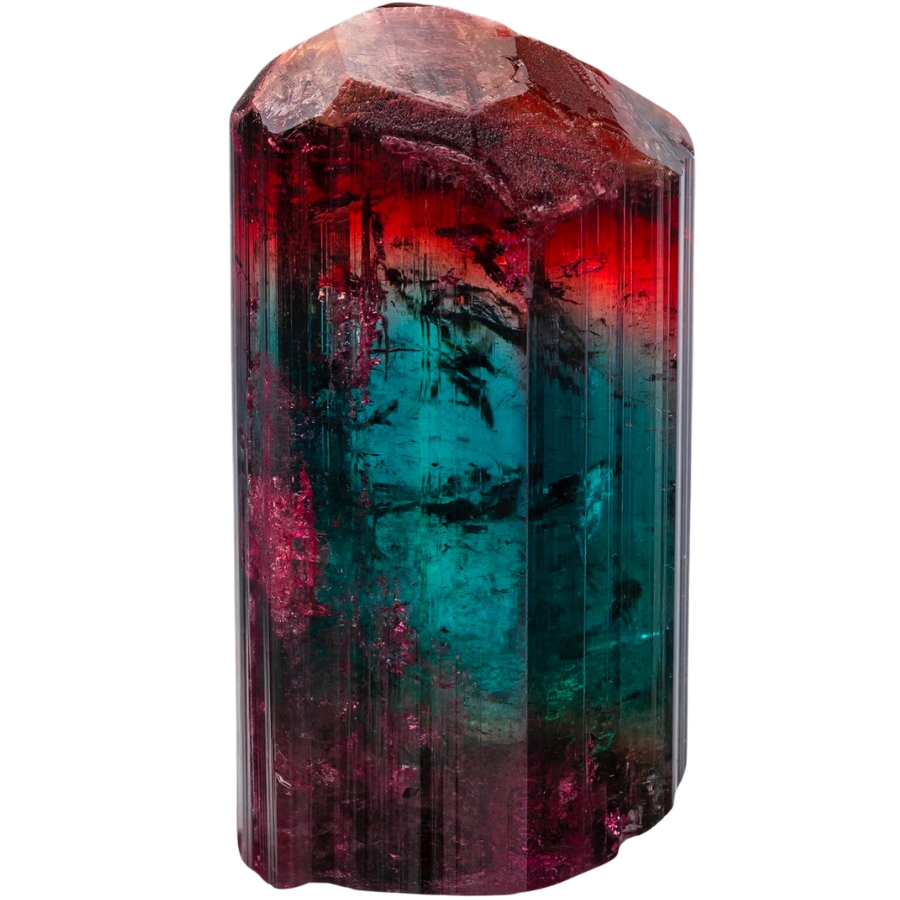
Elbaite is known for its stunning array of colors. It can be found in vibrant greens, rich reds, deep blues, and even pinks. This variety is due to the different elements that are present during its formation, like iron, manganese, and lithium.
Formed under high pressure and temperature, elbaite crystals grow in environments rich in liquids, often in the cavities of rocks.
The clarity and quality of elbaite crystals are top-notch, which contributes to their value. Its durability also makes it ideal for various types of jewelry.
Elbaite also has piezoelectric and pyroelectric properties. This means that when it’s heated or put under pressure, it can generate an electric charge.
This property is not only fascinating but also useful in scientific and industrial applications. For example, it’s used in pressure gauges and other devices where these properties can be applied.
Where you can find elbaite
Elbaite is commonly found in granite pegmatites, which are rocks formed from magma deep underground. Some of the best-known places for finding it include Brazil, as well as Nigeria and Mozambique in Africa.
The USA has some notable locations too, especially in California and Maine. Here’s a helpful article on where to find tourmaline.
DON'T MISS OUT ON ANY GREAT FINDS!
While you're out searching you're going to find A LOT of other interesting rocks and minerals along the way. The last thing you want to do is toss out something really interesting or valuable. It can be easy to misidentify things without a little guidance.
You absolutely need a good reference guide in order to understand what you're looking at!
We've put together a fantastic field guide that makes identifying 140 of the most interesting and valuable rocks and minerals you will find REALLY EASY. It's simple to use, really durable, and will allow you to identify just about any rock and mineral you come across. Make sure you bring it along on your hunt!
Now, back to the identification specifics:
Schorl
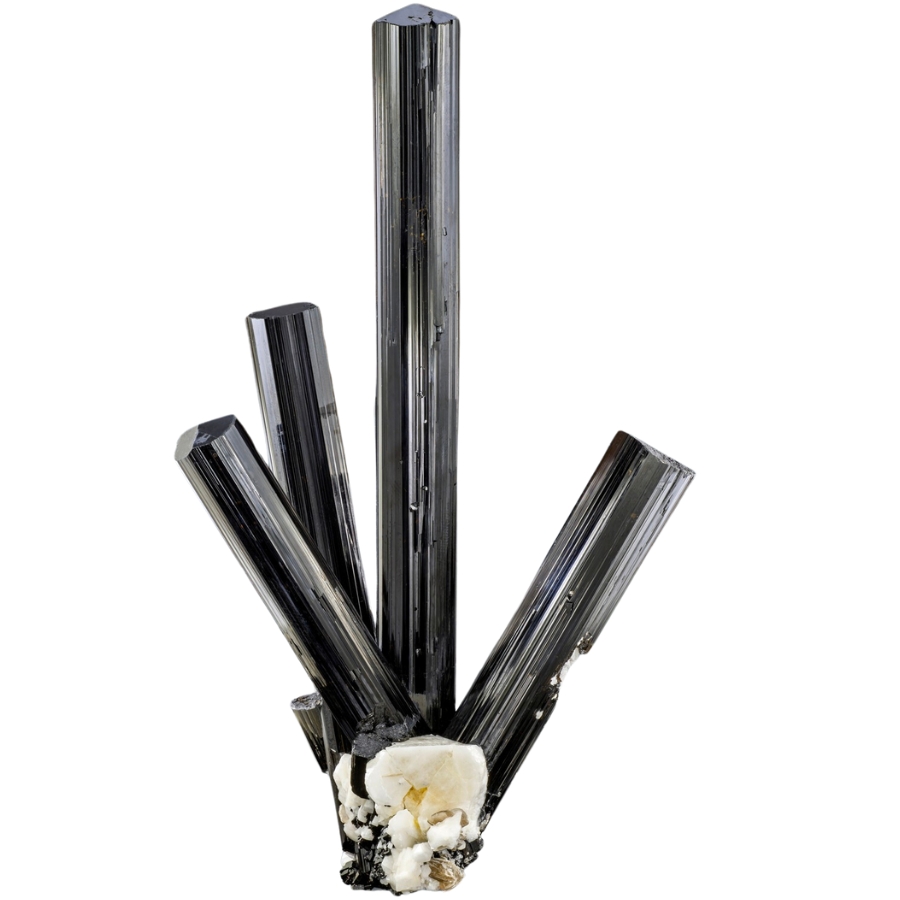
Schorl stands out for its deep black color, often with a hint of blue or brown. It’s the most common type of tourmaline, and its color comes from the high amounts of iron in its structure.
This gemstone has a glassy luster and is often found in long, slender crystals that can be quite striking.
It forms in environments where other minerals are being transformed by heat and pressure, a process known as metamorphism.
Like elbaite, schorl has strong piezoelectric and pyroelectric properties. It’s useful in industrial applications, like in pressure-measuring equipment. It’s also used in scientific research for its ability to withstand high temperatures and pressures.
Despite its dark color, it can be transparent or translucent when sliced thinly. This reveals the complex internal structure of the crystal, which is not apparent when looking at the stone’s dark, opaque surface.
Where you can find schorl
Schorl is commonly found in a variety of geological settings, particularly in granite pegmatites, metamorphic rocks, and certain sedimentary formations. Brazil, Germany, and Namibia are all famous for their schorls.
You can also find it in California, Maine, and Connecticut. For a more detailed guide, head out to our article on the best rockhounding locations.
Dravite
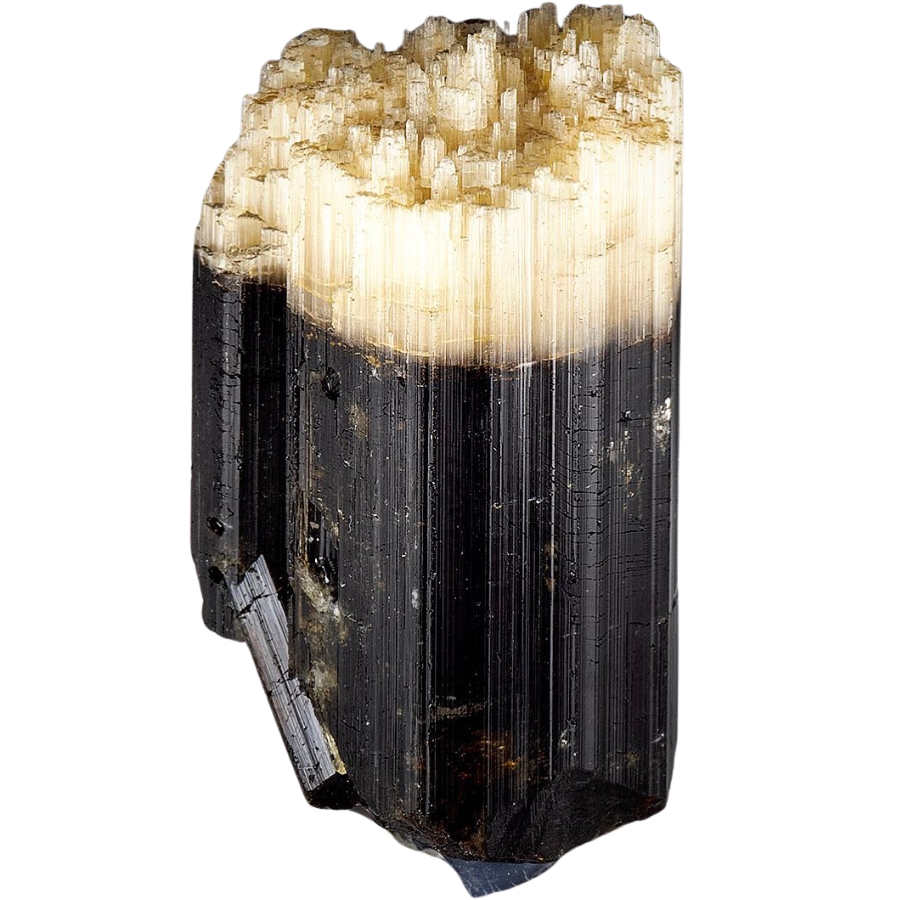
A lesser-known type of tourmaline is dravite. It’s typically brown, ranging from light yellow-brown to dark, nearly black shades. Its color is due to the presence of magnesium in its chemical structure.
Dravite often forms in metamorphic rocks, which are changed by heat and pressure over time. This process allows dravite to develop its distinct color and crystal structure.
While some pieces of dravite are almost opaque, others can be surprisingly clear. Its earthy tones give it a natural, warm appearance, making it a unique choice for those who prefer subtler, more natural-looking gemstones.
It’s also valued for its grounding appearance and for being a more affordable option in the tourmaline family.
Interestingly, dravite shares its chemical composition with another tourmaline called uvite. The difference between them lies in their crystal structure.
Where you can find dravite
You can uncover dravite in metamorphic rocks or granite pegmatites. Australia and Austria are both known for their high-quality dravite specimens.
If you want to search for it within the USA, New York and New Jersey have notable dravite occurrences. Check out our guide on finding crystals near you if you need more details.
Liddicoatite
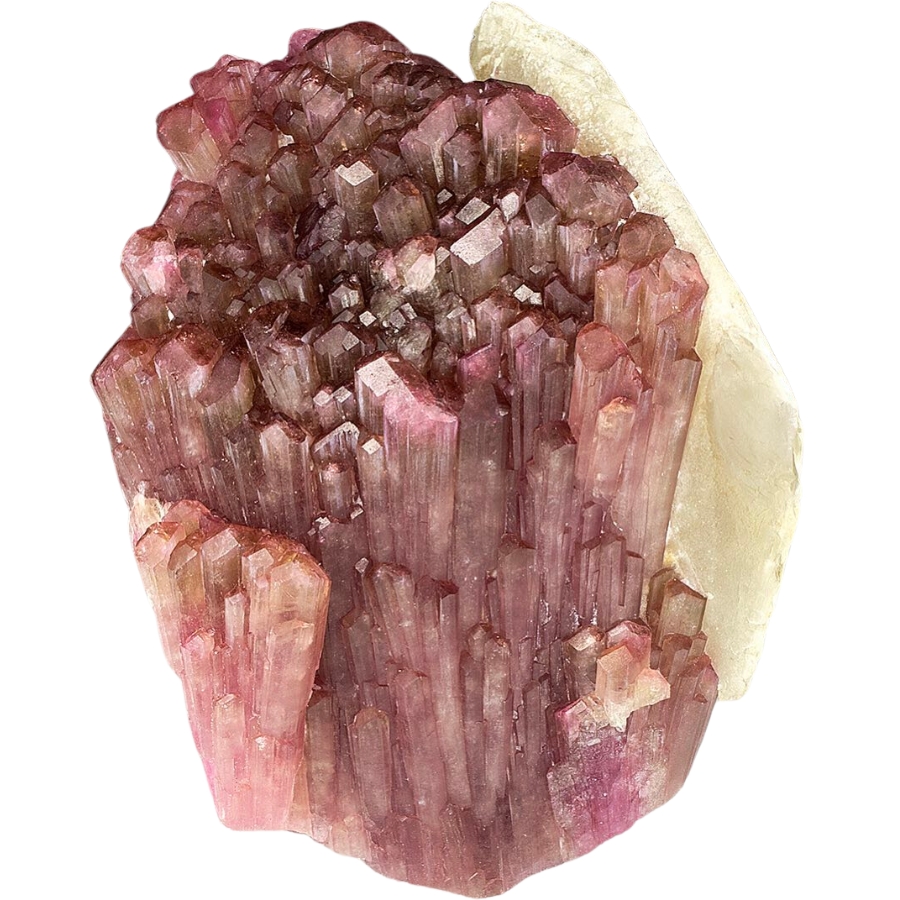
Liddicoatite has striking color zoning, which can include a mix of pink, green, blue, and even black within a single crystal. It’s named after Richard T. Liddicoat, a renowned gemologist.
This tourmaline type’s distinct appearance comes from its complex chemical composition, which includes calcium, a rarity among tourmalines.
It was once considered a variety of elbaite. However, further studies revealed its distinct chemical composition, leading to its classification as a separate species.
Liddicoatite is especially prized for these patterns, which can range from concentric rings to sector zoning, creating stunning visual effects.
Its value lies in its rarity and the beauty of its color zoning. The stone’s ability to display multiple colors in intricate patterns makes it stand out.
Where you can find liddicoatite
Madagascar is one of the most famous locations for finding high-quality liddicoatite, where it’s often discovered in large, well-formed specimens.
Meanwhile, in the USA, California and Maine have some occurrences of liddicoatite, though they are less common. To help you find them, refer to our article on gem mining near you.
Uvite
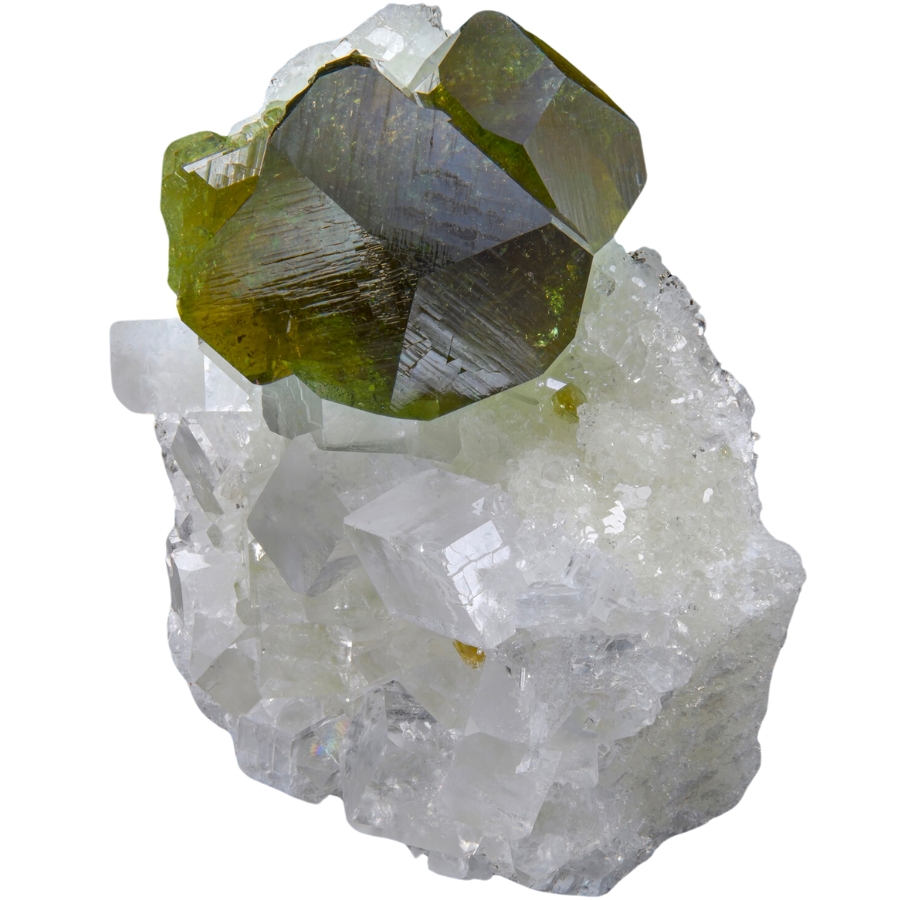
Uvite is known for its deep colors, typically ranging from dark green to brown and sometimes black.
Its crystal structure tends to form in short, stubby crystals, unlike the elongated crystals of other tourmalines. This distinct shape gives it a unique appearance that’s easily recognizable to those familiar with different types of tourmaline.
Uvite forms in environments rich in magnesium and calcium, often associated with metamorphic rocks.
Because of its color, it was once thought to be a type of dravite, which is also brown. Later, it was discovered to have a different chemical composition and crystal structure, which highlights the diversity of tourmaline minerals.
Uvite is valued for its rarity and the rich, deep colors it displays. It’s a favorite among collectors and those who appreciate unique and lesser-known gemstones.
Where you can find uvite
Brazil is a well-known location for finding high-quality uvite, particularly in the state of Minas Gerais. Italy and Sri Lanka are also notable for their deposits.
You can also find great uvite specimens in New York, USA, where it’s found in association with other minerals.
Rubellite
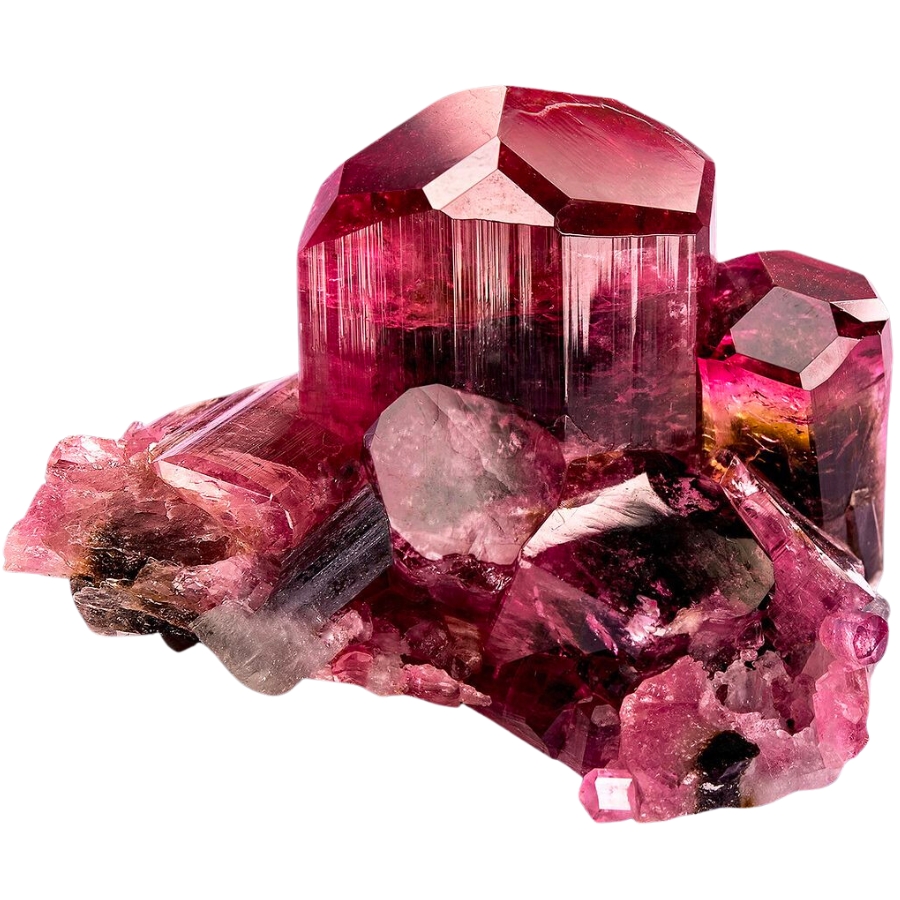
Rubellite has a beautiful range of pink and red colors. These vibrant hues can be pale pink to deep, rich red, sometimes with a hint of purple. Its color comes from the presence of manganese in its structure.
Its transparency and clarity can vary, with some stones being opaque and others being clear and bright.
Like other tourmalines, rubellite is formed in environments rich in minerals, particularly in granite pegmatites and metamorphic rocks.
Unlike many other colored gemstones, its color remains consistent under different lighting conditions, be it natural or artificial light.
Rubellite’s striking color sets it apart from other pink gemstones. Its depth of color is often compared to fine rubies, making it a desirable alternative. Its durability and hardness also make it suitable for everyday wear.
Where you can find rubellite
Rubellite is commonly found in Brazil, a major source of high-quality specimens. The USA also has significant rubellite deposits, particularly in California and Maine.
Other countries with notable rubellite occurrences include Nigeria, Mozambique, and Madagascar.
Indicolite
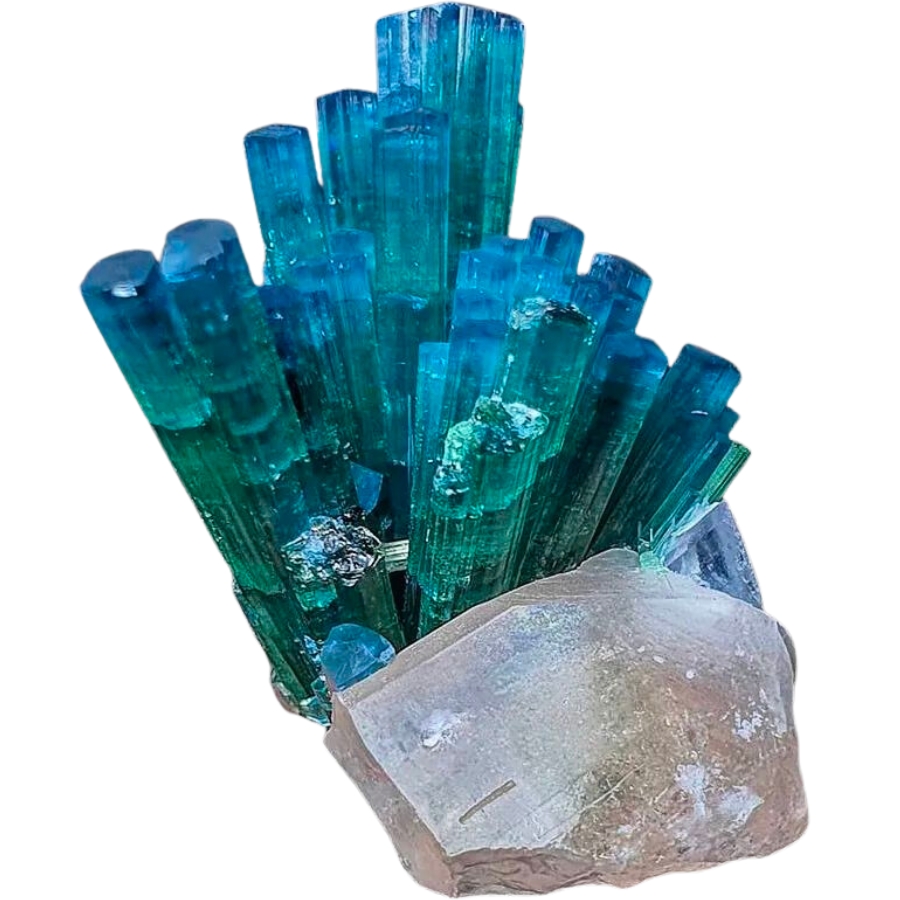
Did you know that tourmaline comes in deep and striking blue color, too? Indicolite’s color can range from a light blue, reminiscent of the sky, to a rich, dark blue that’s almost navy.
This blue hue is due to the presence of iron in its chemical structure, making it a standout in the tourmaline family.
In fact, it’s one of the few naturally occurring blue gemstones. This makes indicolite a fascinating subject for study and appreciation.
This gem’s clarity can also vary, with some stones being nearly transparent and others more opaque.
Blue gemstones are always in demand, and indicolite offers a distinct shade that’s different from other blue stones like sapphire or topaz. Its rarity and the depth of its blue color make it a prized addition to any gem or jewelry collection.
Where you can find indicolite
Like other tourmaline types, indicolite’s well-known source includes Brazil, which produces stones with exceptional color and clarity. Nigeria and Madagascar are also recognized for their deposits of this gem.
The USA has notable indicolite occurrences, too, particularly in California, where beautiful specimens have been discovered.
Verdelite
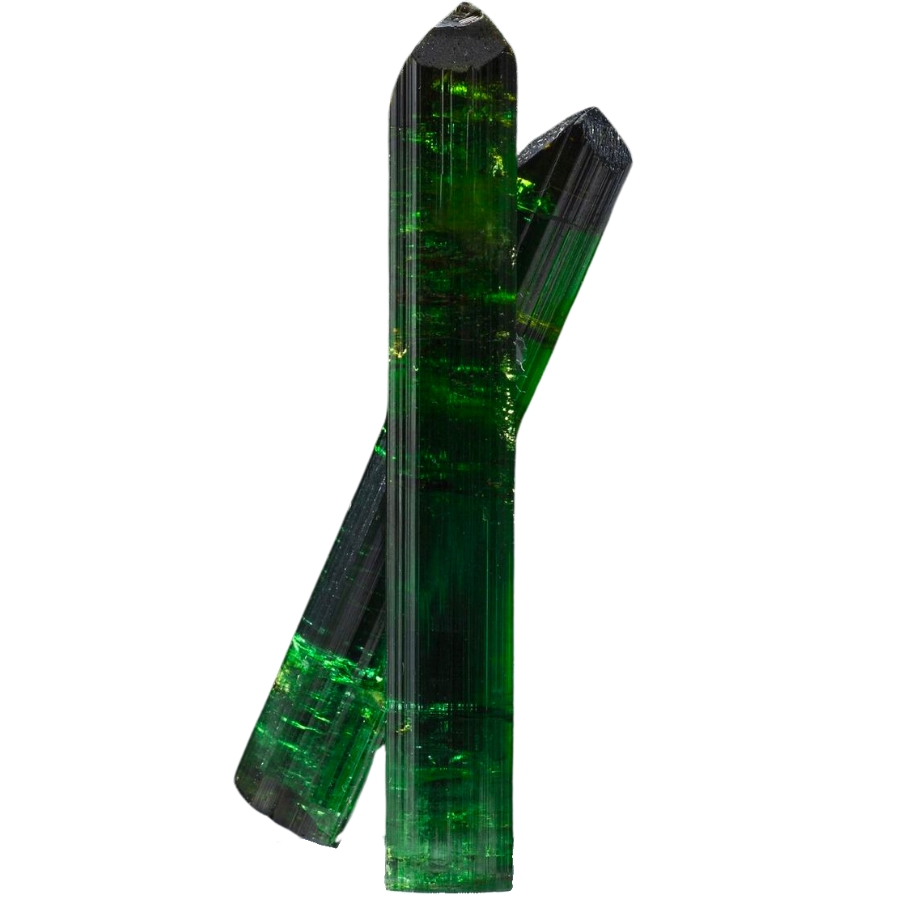
Verdelite is celebrated for its lush green color. This green can range from a light, grassy hue to a deep, rich forest green.
This rock’s color is primarily due to the presence of iron, and it can vary greatly depending on the specific conditions during its formation.
Its formation in environments rich in minerals provides the necessary elements and conditions for verdelite to develop its vibrant color and crystal structure. Its clarity can also range from nearly transparent to opaque, adding to its diverse appeal.
Verdelite is one of the few gemstones that can show a wide range of green shades within the same mineral family. Sound cool, right?
Green gemstones have a timeless appeal, and verdelite offers a unique shade that sets it apart from other green gems like emerald or peridot.
Where you can find verdelite
Brazil is a significant source of verdelite, known for producing stones with vivid and varied green hues. Mozambique, Madagascar, and Nigeria also have notable occurrences of this gem.
In the USA, California and Maine have verdelite deposits, where it’s discovered in both pegmatites and metamorphic rocks.
Paraiba Tourmaline
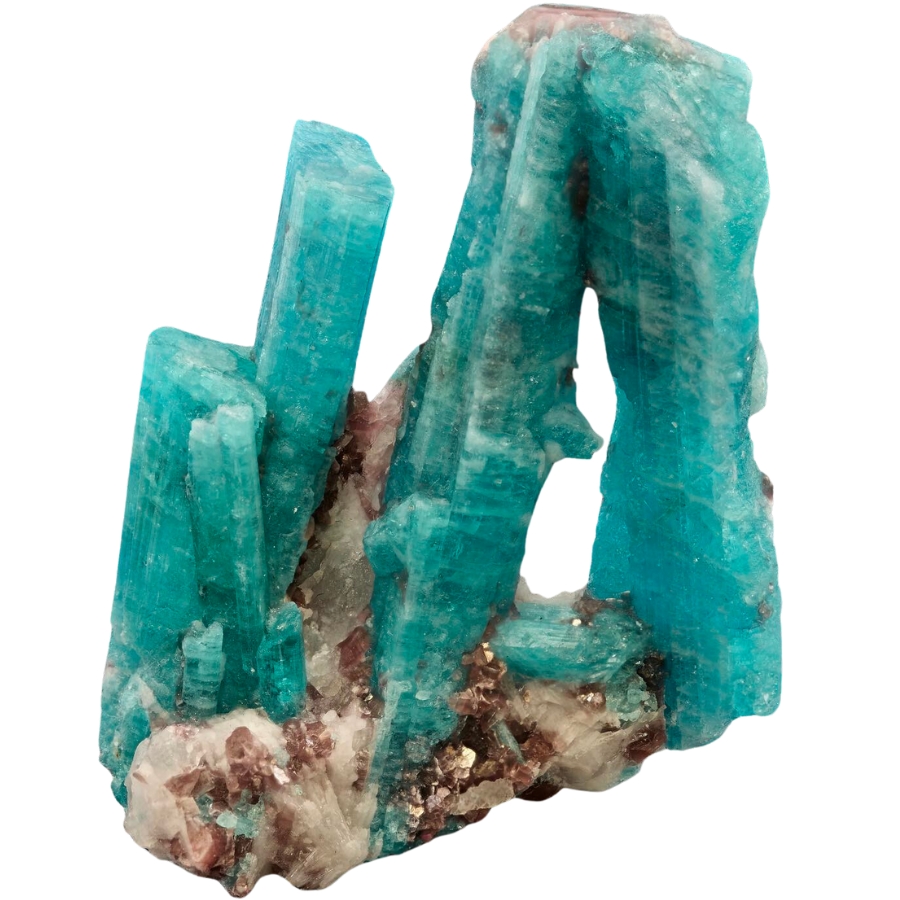
Paraiba tourmaline can captivate you with its neon blue, green, or turquoise colors. Its vibrant hues are due to the presence of copper, a rare occurrence in tourmaline minerals.
This gem’s rarity and the specific conditions required for its formation contribute to its high value and desirability. It’s typically found in small sizes, and large stones are exceptionally rare.
It was only discovered in the 1980s in Brazil’s Paraiba state, from which it gets its name. This recent discovery added a new and exciting chapter to the story of tourmalines, highlighting the potential for finding new and remarkable types.
Paraiba tourmaline is highly valued for its unmatched neon hues and rarity. Its vivid colors are sought after by collectors and jewelry enthusiasts alike.
Its rarity, coupled with the striking beauty of its colors, makes Paraiba tourmaline a coveted gemstone in the market.
Where you can find Paraiba tourmaline
Paraiba tourmaline was first discovered in the state of Paraiba, Brazil. After this initial discovery, similar tourmalines were found in Nigeria and Mozambique, expanding its known locations.
Chrome Tourmaline
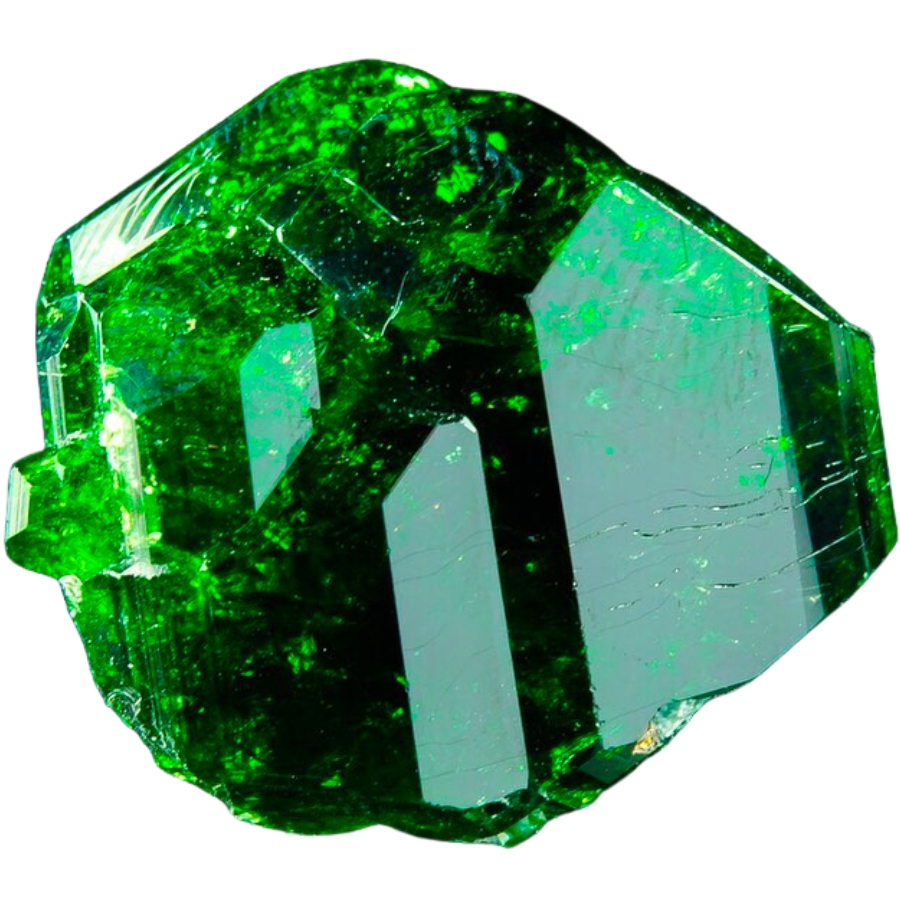
Chrome tourmaline is known for its rich and intense green color. This deep, vivid green is similar to that of emerald, and it’s due to the presence of chromium and sometimes vanadium in the stone.
This specific composition gives chrome tourmaline its distinctive hue, setting it apart from other green tourmalines like verdelite.
It’s even one of the few naturally occurring green gemstones colored by chromium. This element is more commonly associated with coloring emeralds
Chrome tourmaline’s rarity and the specific geological processes required for its formation add to its value. It’s typically found in smaller sizes, and large, high-quality specimens are exceptionally rare and valuable.
This gemstone is highly valued for its intense green color. Its similarity to emerald, combined with its unique properties and rarity, make chrome tourmaline a prized find.
Where you can find chrome tourmaline
Chrome tourmaline is typically found in metamorphic rocks, where chromium and other minerals are present to give it its unique green color. One of its most notable sources is Tanzania, particularly the Merelani Hills area.
In the USA, chrome tourmaline occurrences are rare, but there have been some findings, especially in California.
Watermelon Tourmaline
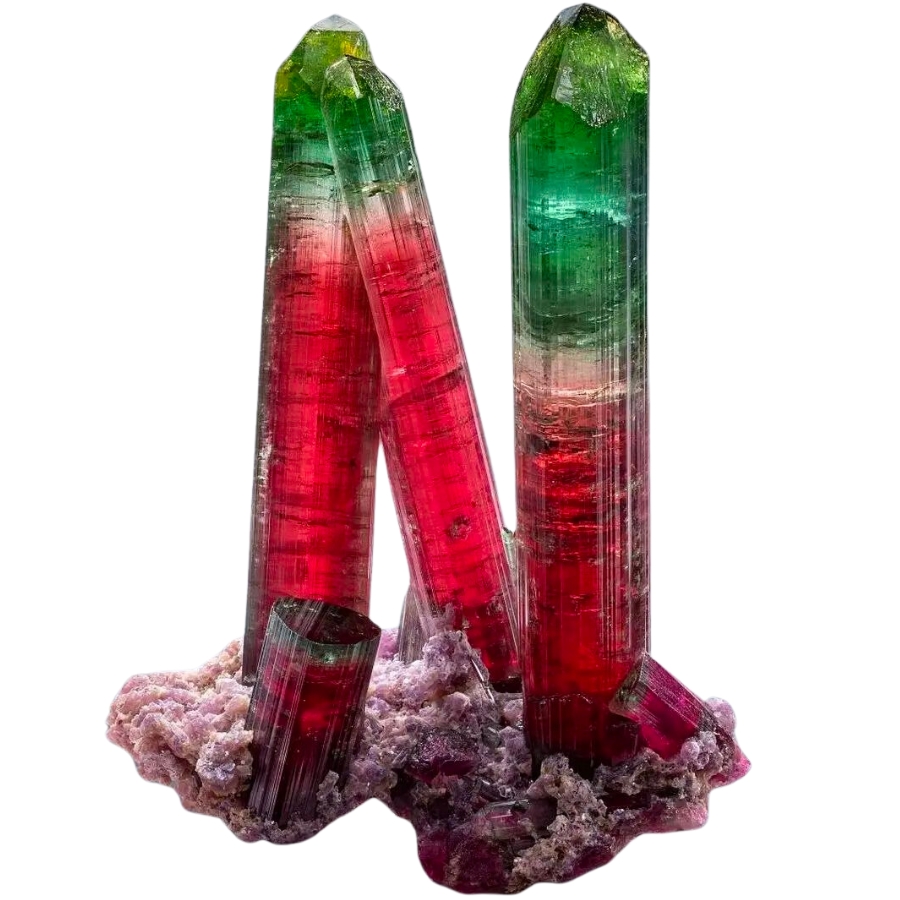
Watermelon tourmaline gets its name from its unique color zoning, resembling a slice of watermelon. It features a green outer rim, often a vibrant or dark green, surrounding a pink or red center.
This distinct coloring is a result of changes in the chemical environment during the crystal’s growth, allowing different colors to develop in the same crystal.
Watermelon tourmaline forms in granite pegmatites. These conditions are ideal for the formation of tourmaline crystals with clear color zoning.
This type of tourmaline is valued for its rarity and the beauty of its color zoning. The contrast between the green rind and the pink or red center creates a stunning visual effect.
It’s often cut in cross-sections to enhance and display its characteristic color zoning. These slices reveal the beauty of the green and pink/red layers, making watermelon tourmaline a popular choice for unique and eye-catching jewelry designs.
Where you can find watermelon tourmaline
You can find pretty watermelon tourmaline pieces in Maine and California, which produce some of the finest specimens. Brazil is another significant source of this gemstone.
Achroite
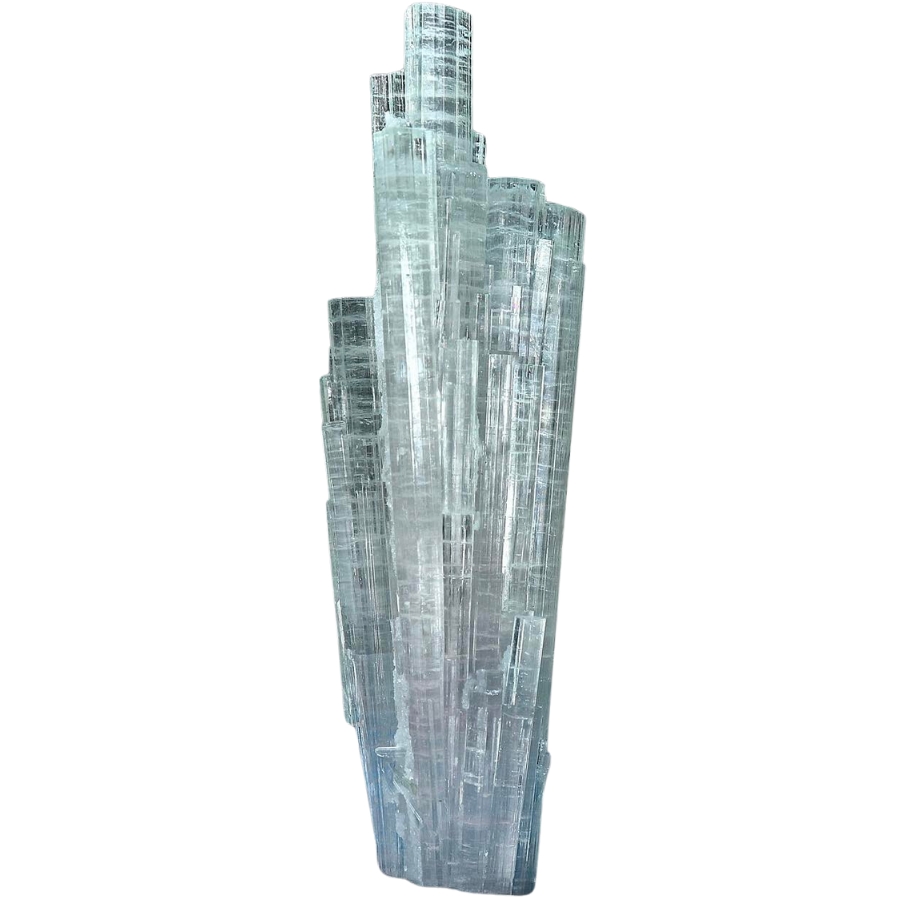
Achroite is a unique gemstone that is colorless or nearly so. Its lack of color is a result of its chemical composition being free from the elements that typically color other types of tourmaline, such as iron, manganese, or chromium.
Achroite forms in the same type of environments as other tourmalines, but the absence of coloring trace elements results in a clear, transparent crystal.
This tourmaline type is valued for its rarity and purity. While colored gemstones are often sought after for their vivid hues, achroite offers a unique appeal in its clarity and transparency.
It can be used in jewelry to provide an elegant, subtle accent or as a collector’s item due to its uncommonness.
Despite being colorless, it still retains the other physical properties of tourmalines, such as its pyroelectric and piezoelectric qualities.
Where you can find achroite
Being a rare variety of tourmaline, achroite notably occurs in Brazil, where it’s occasionally discovered alongside colored tourmalines. California and Maine in the USA have also produced it, though it’s less common.
Siberite
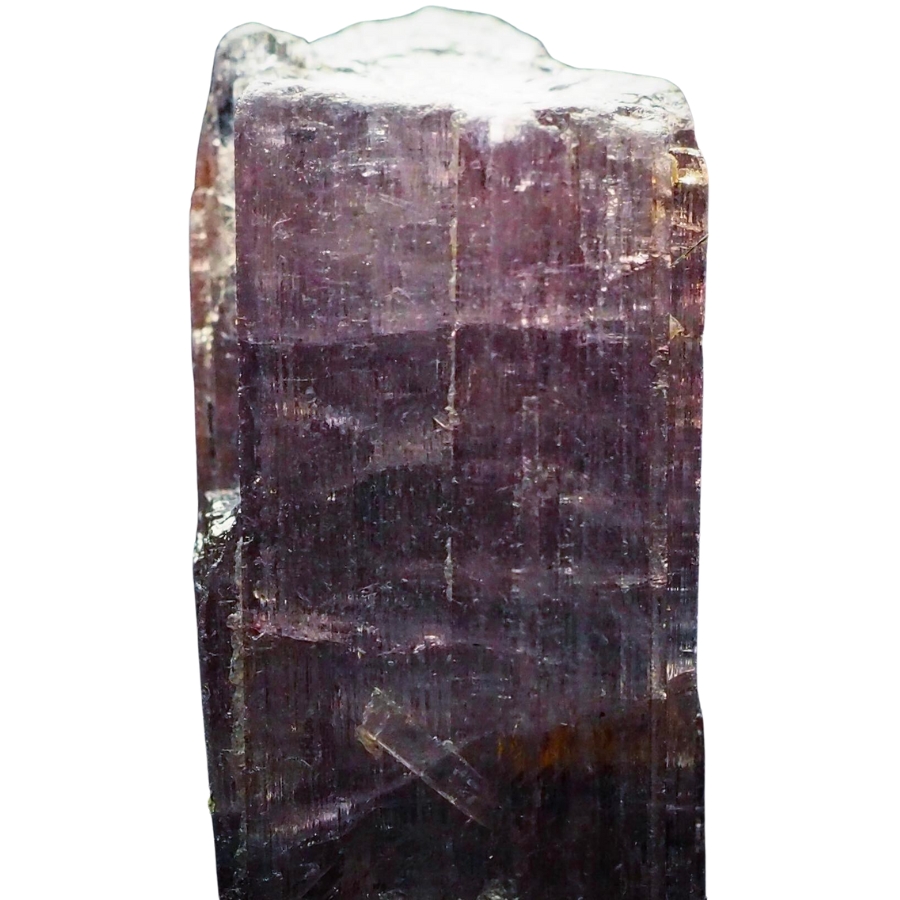
Siberite stands out for its unique lilac or violet color. This beautiful hue sets it apart from other tourmalines, which are often known for their more common green, pink, or blue colors.
It gets its distinctive color from the presence of manganese and iron in its composition, which interact to create its lovely purple shades.
Its name comes from its initial discovery in Siberia, Russia. This historical connection, coupled with its uncommon color, makes it a gemstone with both aesthetic appeal and a story to tell.
The beauty and rarity of siberite also make it a gemstone that’s both valued and sought after.
Its soft purple tones also offer an alternative to more traditional gemstone colors, making it a popular choice for jewelry that stands out.
Where you can find siberite
Known for its lilac or violet color, siberite can be found in its initial place of discovery in Russia. It’s not exclusive there, though, so you can also find it in California and Maine. Just don’t expect too much as it is a less common variety of tourmaline there.
Canary Tourmaline
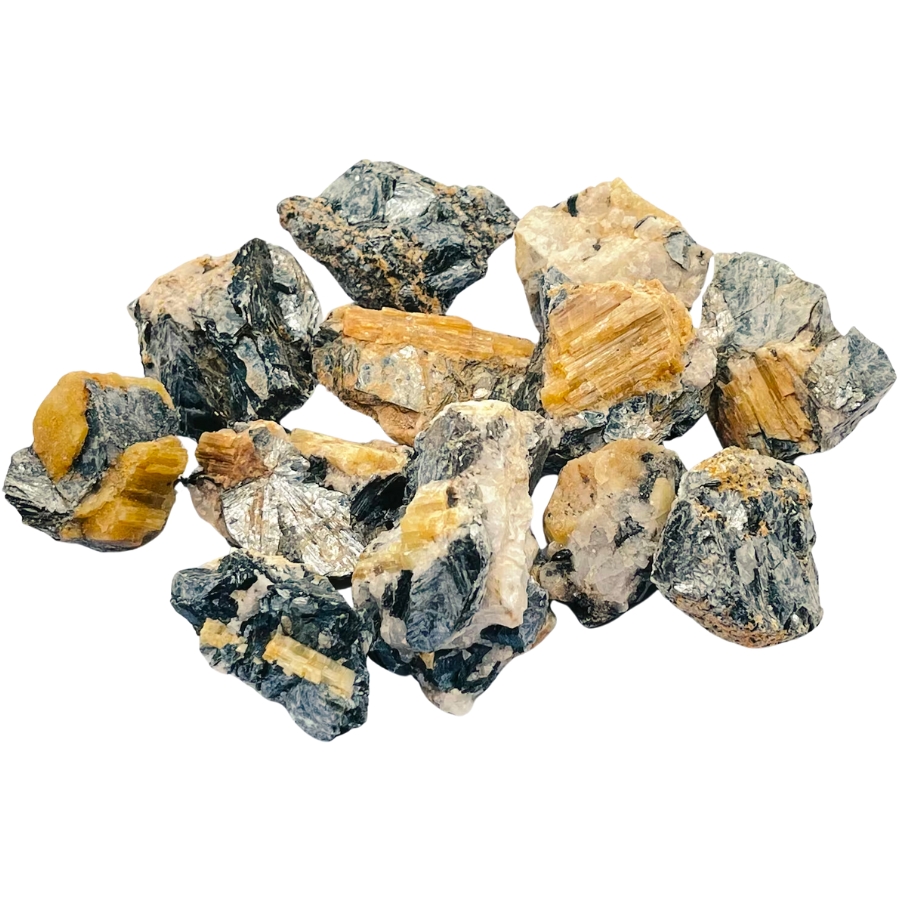
Canary tourmaline is known for its bright, vivid yellow color, which is reminiscent of a canary bird. This striking hue sets it apart from other tourmalines.
Its yellow color is due to the presence of trace elements, such as manganese and iron, in specific concentrations and states within the crystal structure.
This gemstone is highly valued for its unique and vibrant color. Yellow gemstones are less common, and canary tourmaline offers a bright and cheerful shade that’s sought after in the gemstone market.
Its rarity and distinctiveness make it a prized addition to collections and a popular choice for unique jewelry designs.
Like other tourmaline types, canary tourmaline exhibits the same range of properties, including piezoelectricity and pyroelectricity.
Where you can find canary tourmaline
While canary tourmaline is relatively rare, Brazil is known for producing some beautiful specimens. In the USA, states like California have also discovered canary tourmaline, although it is less common.
Cat’s Eye Tourmaline
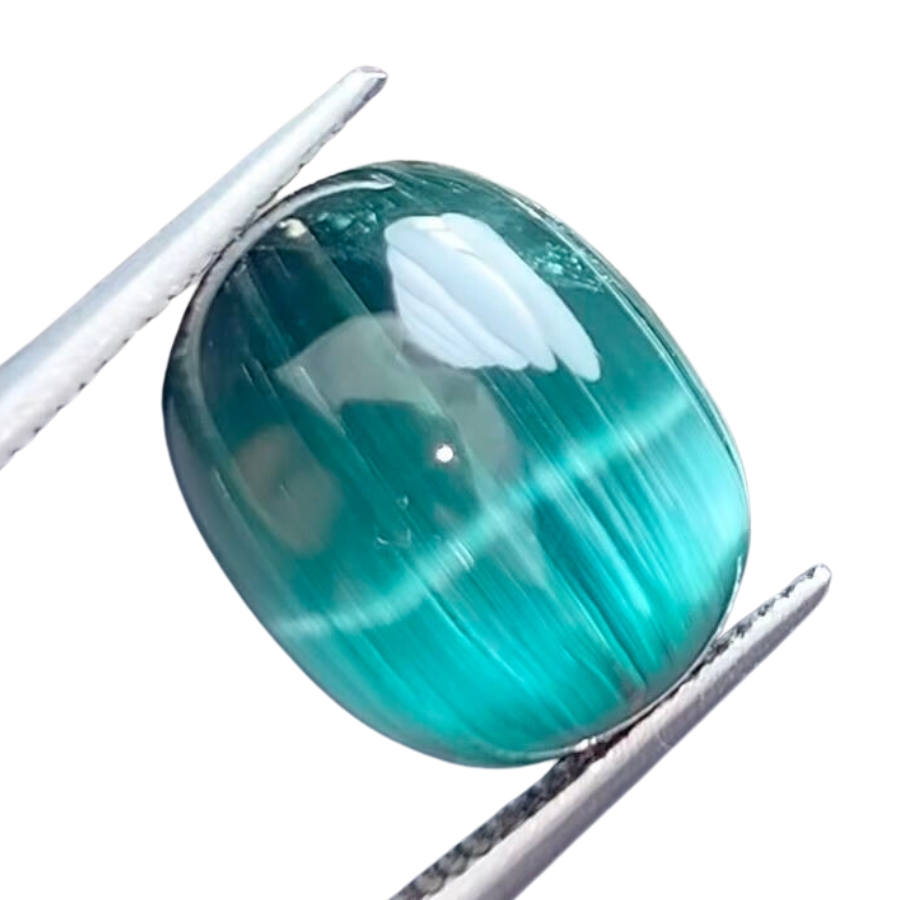
Cat’s eye tourmaline displays a fascinating visual effect known as chatoyancy. This effect, resembling the slit eye of a cat, appears as a reflective band across the stone.
It’s caused by parallel fibrous or needle-like inclusions within the tourmaline that reflect light in a narrow band. The specific conditions during its formation, particularly the presence of these fibrous inclusions, lead to the cat’s eye effect.
It can come in various colors, but the chatoyancy is most pronounced in stones with a significant amount of inclusions.
Cat’s eye tourmaline is valued for its unique optical phenomenon and rarity. The quality of the cat’s eye effect, along with the color, clarity, and cut of the stone, determine its value.
The best way to showcase its chatoyancy is through a cabochon cut, a style where the stone is shaped and polished into a smooth, rounded dome rather than faceted.
Where you can find cat’s eye tourmaline
Cat’s eye tourmaline can be uncovered in Brazil, which is known for producing high-quality specimens with strong chatoyancy. In California and Maine, cat’s eye tourmaline has also been discovered.

